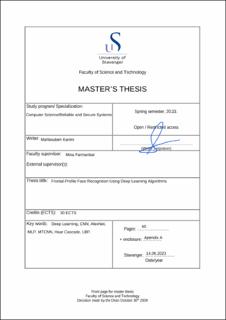| dc.description.abstract | This study investigates the impact of pose variation, particularly extreme poses such as the profile view, on the performance of biometric recognition systems. The study employs the Local Binary Pattern (LBP) approach in combination with convolutional neural networks (CNNs) to extract discriminative features from facial images. Feature-level and decision-level fusion techniques are utilized to enhance the system's performance. The experiments are conducted on the CFPW dataset, which consists of frontal and profile faces captured under diverse conditions. The results demonstrate that multimodal approaches outperform unimodal ones, with the fusion of frontal and profile images using the AlexNet model achieving the highest accuracy rate of 96.40\%. This finding underscores the significance of incorporating multiple modalities, specifically frontal and profile images, to achieve robust and accurate face recognition. By combining these modalities, the system effectively mitigates the challenges posed by pose variation, resulting in improved recognition performance.
The extraction of valuable features is crucial for the development of accurate face recognition systems. This study employs the LBP approach in conjunction with CNNs to extract discriminative features from facial images, enabling effective facial representation.
To enhance the system's performance, feature-level and decision-level fusion techniques are employed. Feature-level fusion combines features acquired from both frontal and profile faces, while decision-level fusion combines classification decisions from individual classifiers. These fusion techniques leverage the complementary information provided by different modalities, improving overall recognition accuracy.
The findings emphasize the effectiveness of multimodal approaches in biometric recognition systems. The utilization of multiple modalities, along with appropriate fusion techniques, enables the system to overcome limitations associated with pose variation and enhance the accuracy and reliability of face recognition. These insights contribute to the advancement of biometric recognition systems and open avenues for more robust and versatile applications in various domains. | |
